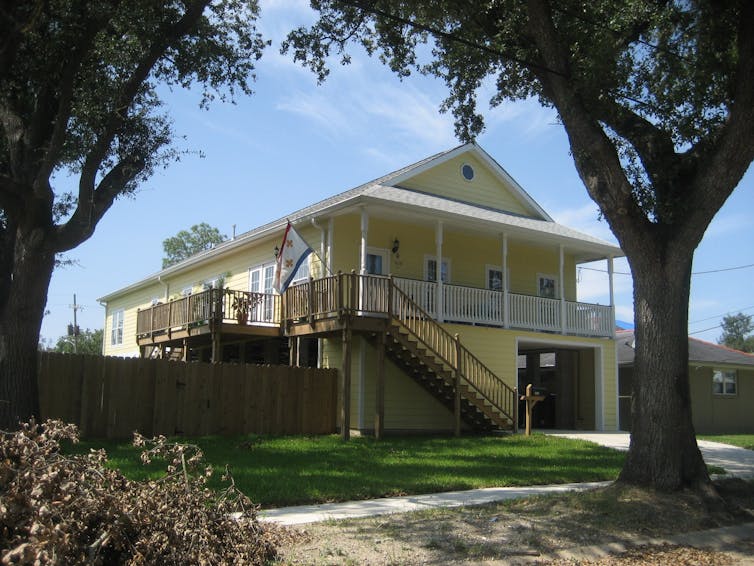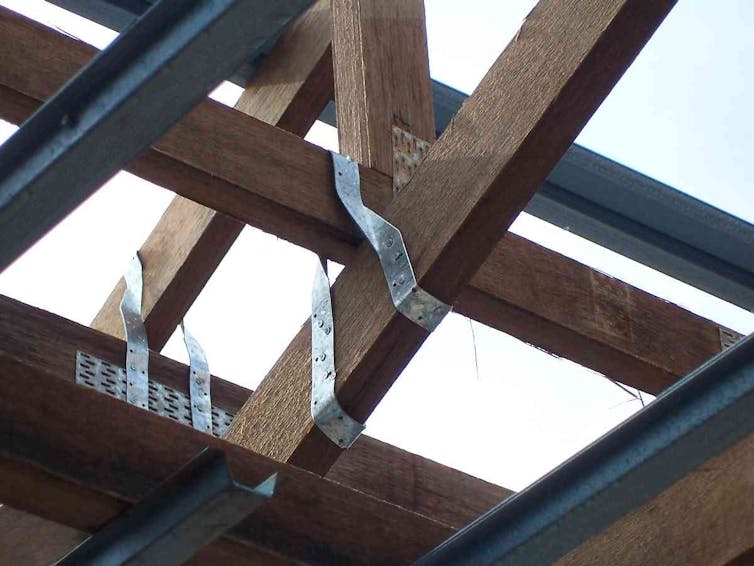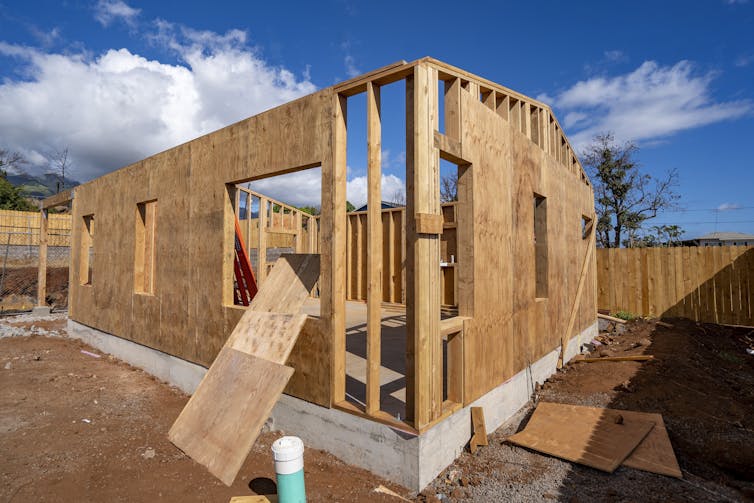Disaster survivors want to rebuild safer, more sustainable homes, but cost misperceptions often stand in the way
- Written by Susan Ostermann, Assistant Professor of Global Affairs, University of Notre Dame
As Florida and the Southeast begin recovering from 2024’s destructive hurricanes, many people are asking: How can we rebuild sustainably and in a way that avoids the same damage, costs and trauma in future storms?
There are proven ways to strengthen homes that pay off in the long run, such as installing hurricane straps to tie down roofs in coastal areas. But while homeowners have a clear desire to build safer and more resilient homes, they often run into roadblocks.
As a civil engineer and a regulatory expert, we have been working with communities as culturally and politically different as Hawaii, Colorado, Alaska and Puerto Rico as they recover from disasters to understand what stands in the way of a sustainable, resilient recovery.
Up-front costs have played a big role in how these communities recover, but so have homeowners’ and builders’ perceptions – and misperceptions – about costs and regulations.
Up-front rebuilding costs
After a disaster, people need to get into housing quickly. At the same time, the costs to rebuild sustainably and resiliently can be high. Builders and building supplies often experience a demand shock, which can raise costs and create delays.
This is set against a backdrop of the Federal Emergency Management Agency’s thinly stretched budget, which is intended for emergency response, and a widespread insurance pull-back from disaster-prone markets. Other government grants for rebuilding take months to arrive.
Even for people whose homes are insured, payments rarely cover anything different from what existed before. Thus, the amount of money available for rebuilding can be considerably less than the actual cost of rebuilding resiliently.
 After Hurricane Katrina in 2005, many Louisiana homes were rebuilt with the living space on the second story, with garage space below, to try to protect the home from future flooding.Infrogmation of New Orleans via Wikimedia, CC BY-SA
After Hurricane Katrina in 2005, many Louisiana homes were rebuilt with the living space on the second story, with garage space below, to try to protect the home from future flooding.Infrogmation of New Orleans via Wikimedia, CC BY-SALess quantifiable, but no less real, is the cost of navigating the rebuilding process. For many people, this starts with figuring out how to apply for government aid, dealing with insurance companies’ requirements, and then deciding how and when to build.
All require research, paperwork and meetings.
A critical player in the rebuilding process is local building departments. These departments manage construction standards, approval processes, permits, fees and other aspects of what gets built. Those are vital to safe and resilient housing, but the longer and more complicated the building process, the more fatigued residents get, both financially and psychologically.
Navigating bureaucracy can be challenging for everyone, but it can be especially hard on people who lack paperwork, don’t speak English or don’t have a relationship with a bank, which we often saw after Hawaii’s devastating Maui fires in 2023.
Building back better costs less than people think
We also have found significant problems with perceived costs. Both residents and building professionals often overestimate up-front costs of adopting newer technologies that may have substantial benefits for sustainability and safety.
After the Marshall Fire in Boulder County, Colorado, in 2021, we conducted interviews and surveys with builders and owners of some of the more than 1,000 homes and businesses destroyed by the blaze. We found that some builders discouraged residents from pursuing new technologies, such as installing energy-efficient air-source heat pumps. Builders quoted installation costs ranging from no additional premium over conventional technologies to tens of thousands of dollars, creating significant cost uncertainty for residents.
We also heard repeatedly from building professionals on Maui that the pace of change in the building industry, especially changes driven by regulation, can be challenging, costly and require time to retrain crews.
 Metal tie-downs are fairly cheap and can help keep the roof connected to the walls during strong winds. They have become common in communities at risk from hurricanes.Billbeee via Wikimedia, CC BY-SA
Metal tie-downs are fairly cheap and can help keep the roof connected to the walls during strong winds. They have become common in communities at risk from hurricanes.Billbeee via Wikimedia, CC BY-SAFor example, to withstand high winds in Hawaii, many homes should be built with straps connecting the roof to the wall framing system. However, one resident who worked in the building sector showed us the straps at his rental property, drawing our attention to the fact that they were installed incorrectly. Builders also told us that the large number of nails required in some situations causes splits in the framing system, leading builders to question the regulatory standards.
In some cases, building professionals or residents may perceive that something is more expensive than it actually is. In Puerto Rico, our data showed that communities were surprised that hurricane straps, which can help keep wooden roofs from tearing off in high winds, can be quite cost effective. One local builder said he was surprised that “it is $35 to make sure your roof doesn’t blow away.”
Getting better information
What’s clear from our research is that both residents and builders need accurate, easily accessible information about how to efficiently reduce rising disaster risk.
People were seeking this information across all of our cases. However, people’s knowledge is often circumscribed by their past experiences.
 Construction has been slow in Lahaina, Hawaii, where most of the town burned in a wildfire in 2023. This property, shown in July 2024, was one of the first where rebuilding could begin because the home had been under construction before the fire and still had open permits.AP Photo/Mengshin Lin
Construction has been slow in Lahaina, Hawaii, where most of the town burned in a wildfire in 2023. This property, shown in July 2024, was one of the first where rebuilding could begin because the home had been under construction before the fire and still had open permits.AP Photo/Mengshin LinFor example, Puerto Ricans have been working hard to secure the panels on their roofs because they have seen these panels fly away in hurricanes. But they are not as commonly addressing the roof structure and its connections.
In Alaska, where large earthquakes are common, many people we spoke to believed inspections would make sure foundations were being built correctly. But in most Alaskan communities, this doesn’t happen. Anchorage’s Building Safety Service Area is an exception.
As a society, streamlining the rebuilding process so it delivers pragmatic information that emphasizes high-impact changes could make resilient choices easier. This technical information is available in the form of technical reports and government studies, but it still needs to get to both builders and residents in a clear and concise manner. This is rare today, though some organizations are making efforts, such as the Colegio de Arquitectos y Arquitectos Paisajistas de Puerto Rico – the College of Architects and Landscape Architects of Puerto Rico – which shares easy-to-understand advice for homeowners.
Simple changes can make a big difference. Data from the Marshall Fire in Colorado suggests that wood fences contributed to the fire’s spread. Reducing their use could cheaply and effectively reduce the risk of homes burning in future fires.
Making the rebuilding process as efficient as possible can also be a big win without any change to existing requirements. That has been happening on Maui with the implementation of third-party plan review, which has reduced a 400-plus day process to 15 days. With third-party plan review, building regulations remain the same, but instead of a government worker reviewing a building permit for compliance, a contractor does so.
Finally, while there are unavoidable costs to rebuilding, there are also real benefits in how mitigation and resilience measures reduce long-term costs to society. Incentives, and disincentives, can help homeowners, building professionals, insurers and governments invest in more resilient buildings.
Susan Ostermann receives funding from the National Science Foundation and the University of Notre Dame.
Abbie B. Liel receives funding from the National Science Foundation.
Authors: Susan Ostermann, Assistant Professor of Global Affairs, University of Notre Dame

